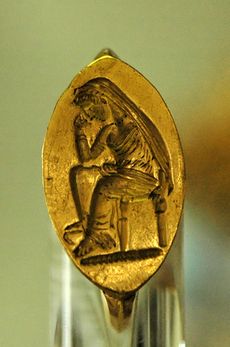پنلوپي

في أوديسة هومر، پنلوپي (Penelope؛ /pəˈnɛləpiː/ pə-NEL-ə-pee؛ باليونانية: [Πηνελόπεια، Pēnelópeia، أو Πηνελόπη, Pēnelópē] Error: {{Lang}}: text has italic markup (help)) هي الزوجة الوفية لأوديسيوس، التي صدت طالبي الزواج منها في غيابه الطويل وفي النهاية يجتمعان مرة.
اقترن اسمها تقليدياً مع العفة الزوجية،[1] وكان ذلك الاقتران موجوداً أيضاً بالعصرين اليوناني القديم والروماني، ولكن بعض القراءات النسوية الحديثة تطرح تفسيراً أكثر غموضاً.[2]
دورها في الأوديسة


پنلوپي هي زوجة الشخصية الرئيسية، ملك إيثاكا، أوديسيوس (عوليس في الأساطير الرومانية)، وابنة إيكاريوس من زوجته پريبويا. وكان لها ابن وحيد من أوديسيوس، تلماخوس، الذي وُلِد قبيل ذهاب أوديسيوس للقتال في حرب طروادة. وقد انتظرت عشرين عاماً عودة زوجها النهائية،[3] وخلال ذلك الوقت لاقت مصاعب في صد عروض الزواج من 108[4] طالبي زواج بغيضين (تصدرهم أنتينوس وضموا أگلاوس، أمفينوموس، Ctessippus, Demoptolemus, Elatus, Euryades, Eurymachus وPeisandros).
ولدى عودة أوديسيوس، متخفياً كمتسول عجوز، يجد أن پنلوپي قد ظلت وفية. فقد اختلقت الحيل لتطويح ملاحقيها، احدى تلك الحيل كانت التظاهر بغزل كفن لوالد أوديسيوس العجوز لايرتس وادعاء أنها سوف تختار زوجاً حين تنتهي من نسج الكفن. وكل ليلة على مدى ثلاث سنوات، تنكث جزءاً من الكفن الذي نسجته، حتى اكتشفت ميلانتو، أحد خادماتها الإثنتي عشر الخائنات، حيلتها، وأبلغت ملاحقي پنلوپي بالحيلة.
بسبب جهودها لاحباط أي زواج ثاني، فإن پنلوپي كثيراً ما تُرى كرمز للعفاف الزوجي ونحن نـُذكـَّر عدة مرات بعفافها. ولكن نتيجة لتدخل أثينا، التي أرادت من پنلوپي "أن تكشف نفسها لطالبيها، لتشعل الحسرة في قلوبهم وتكسب المزيد من الشرف في أعين زوجها وابنها عن ذي قبل"، فتظهر پنلوپي لأمام طالبيها (xviii.160–162). وكما تعلّق أيرين دى يونگ:
As so often, it is Athena who takes the initiative in giving the story a new direction ... Usually the motives of mortal and god coincide, here they do not: Athena wants Penelope to fan the Suitor's desire for her and (thereby) make her more esteemed by her husband and son; Penelope has no real motive ... she simply feels an unprecedented impulse to meet the men she so loathes ... adding that she might take this opportunity to talk to تلماخوس (which she will indeed do).[5]
أيقونات
الهامش
- ^ J.W. Mackail, with Penelope in the Odyssey (Cambridge University Press, 1916), epitomizes the traditional view of the dutiful Penelope.
- ^ Marylin A. Katz, Meaning and Indeterminacy in the Odyssey (Princeton University Press, 1991)
- ^ أمضى أوديسيوس عشر سنوات في حرب طروادة وعشر سنوات في طريق عودته.
- ^ Homer. The Odyssey, Book XVI, in The Iliad & The Odyssey. Trans. Samuel Butler. p. 628. ISBN 978-1-4351-1043-4
- ^ , Irene de Jong. (2001). A Narratological commentary on the Odyssey, p. 445. Cambridge University Press, ISBN 0-521-46844-2
مصادر أساسية
- أوڤيد، هرويدس I
- هومر، الأوديسة
- Lactantius Placidus, Commentarii in Statii Thebaida
مصادر ثانوية
- Finley, M.I. The World of Odysseus, London. Pelican Books (1962)
- The Penelopiad, by Margaret Atwood, retells the story of Odysseus from the point of view of Penelope.
- Seth L. Schein, ed. (1996). Reading the Odyssey: Selected Interpretive Essays. Princeton University Press. ISBN 0-691-04440-6.
{{cite book}}:|author=has generic name (help) - del Giorgio, J.F. The Oldest Europeans A.J. Place (2006). It underlines Penelope's power and her role in a cataclysmic time.
- Richard Heitman (2005). Taking Her Seriously: Penelope and the Plot of Homer's Odyssey. Michigan University Press, Ann Arbor. ISBN 0-472-11489-1.
وصلات خارجية
- Odyssey in English on the Perseus Project
- Penelope Unravelling Her Web - a painting of Penelope by Joseph Wright of Derby (from the Getty Museum)
- 'Penelope and the Suitors', a painting by John William Waterhouse; explore other paintings depicting Penelope
